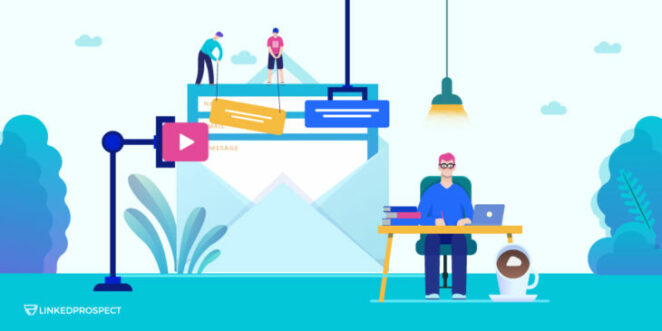

According to Hubspot, LinkedIn’s lead conversion rates are 3x higher than other major ad platforms. With over 800 million members on LinkedIn filled with professionals and decision-makers, it can seem like an absolute goldmine when it comes to marketing.
But finding where your potential prospects hang out is only the beginning of the battle. LinkedIn has become flooded with generic, mass-produced outreach messages from businesses trying to attract new leads to their business.
If you’ve found yourself spending time, energy, and resources sending outreach messages to potential clients with zero responses, you’re not alone.
This is why A/B test outreach campaigns are crucial to building a successful lead generation strategy.
In this article, we’ll tell you everything you need to know about how A/B testing can improve your overall response rate.
Let’s jump in.
Contents
What is A/B Testing?
A/B testing, also known as split testing, is the process of using different variations of a marketing campaign to see what works better.
For example, you might send out two similar marketing campaigns that only have slightly different factors (like a change in headline) to see which one gets the best results. This can be done for email marketing campaigns, outreach messages, landing pages, and many more aspects of your business.
A/B testing is one of the best ways to optimize the results of your campaigns because you get first-hand experience to see what your audience will engage with the most.
A/B testing can enable your business to:
- Improve your user’s experience
- Understand pain points and bottlenecks in your funnel
- Increase ROI for different outreach campaigns
The more you test and optimize your outreach messages, the more engagement and response you’ll get. This will ultimately lead to higher conversions and more customers for your business.
How Does A/B Testing Work?
The idea behind split testing is pretty simple. When it comes to deciding what to put into your outreach messages, most likely, you’ll come up with several different ideas, headlines, and variations of your campaign.
By organizing your campaigns into two equal groups with slight changes, you can easily see which message gets more opens, click-throughs, replies, and conversions in real time.
You might be asking yourself what to split test first. In reality, the options are endless, but it’s best to keep things as simple as possible to begin with. Focus on small, specific details. If you change too many things, it will be harder to understand what changes are leading to success (and failure).
Just make one change at a time. Here are some aspects you can A/B test:
- Changing the headline
- Changing the call-to-action (CTA)
- Changing the opening line or preview
- Adding links to your social media or portfolio
- Adding a case study
- Adding pictures
- Shorter vs. longer versions of the same message
After deciding on a single factor to change, you can simply send out the two variations of the message to two different groups on LinkedIn. Track the number of opens, replies, click-throughs, and conversions. As you get more information, you can improve your message and create an even more refined A/B test for the next round.
Why is Split Testing Important?
Sending out marketing and outreach campaigns without actually understanding what’s working and what isn’t is like going fishing blindfolded. Sure, you may get a catch every so often, but if you can’t see and learn from the environment, your strategy won’t be as effective as it can be.
Also, people who don’t split tests tend to rely on industry best practices. The problem is that every niche, industry, and audience is different. Although it might be a good place to start, there’s nothing better than getting real-time, hands-on experience on what works best for your audience.
Split testing gives you concrete data specifically for your message and audience that you can work on to improve your campaigns.
A/B Testing on LinkedIn
There are several different kinds of LinkedIn posts that you can split test to make sure your campaigns are being fully optimized. If you’re running paid ads, you can split test both:
- Sponsored content – paid campaigns that come posted from your company page
- Direct sponsored content – paid campaigns shown on the feed that is not from the company page
However, one of the biggest benefits that the LinkedIn platform offers is the ability to do outreach messaging to individual prospects.
As we mentioned earlier, it’s important to note that direct messaging has become diluted with sales-y, generic, mass-produced messages from businesses trying to find leads.
But if you can refine your outreach strategy through split testing and create a great outreach campaign that can stand out against the crowd, LinkedIn outreach messaging can be one of the best tools in your arsenal for growing your brand.
How to Execute A/B Test Outreach Campaigns
Split-testing campaigns on LinkedIn is quite simple. Let’s start with an example of creating an A/B test for a sponsored campaign when advertising on LinkedIn. Follow these steps:
- Create a campaign to promote on LinkedIn (this means setting the budget, bidding, creating content, etc.)
- Create two identical versions of the marketing campaign
- Change only one variable on one of the campaigns that you want to test (headline, picture, CTA, etc.)
- Run both campaigns, keep track of the statistics, and analyze which one worked better
- Make the necessary changes and split test again if necessary
If you want to split test a cold outreach message campaign, you can follow these steps:
- Create a draft of an outreach message that you want to send
- Create two identical versions of the message
- Change only one variable in the campaign (message preview, CTA, etc.)
- Send the messages to two different groups of people individually
- Keep track of the open rate, click-through rate, and conversion rate
- Make the necessary changes and split test again if necessary
Remember to only change one aspect of your campaign. Otherwise, it will cause confusion as to what is making the change in performance.
Optimize Targeting Through Split Testing
We don’t have to stop at split testing LinkedIn ads and outreach messages. You can also A/B test how you’re targeting your audience as well.
Most likely you’ve been targeting a certain demographic and audience when it comes to your advertisements, but don’t assume you’re already targeting the most optimized audience.
You can split test the same advertisements to different groups of people to see what performs better. Keep optimizing your targeting until you find what works best.
How Long Should You A/B Test?
The amount of time that you spend A/B testing depends on the platform you’re advertising on, your niche or industry, your audience, and more factors. But LinkedIn recommends running your campaign for at least two weeks before ending it.
This will allow you to get a wealth of statistics and information to go through. If your ads are performing well, you can always let them run longer to see how well they can perform.
On the other hand, there is such a thing as letting campaigns run for too long. If you allow dud campaigns to keep running, you’ll waste time and money that could be spent elsewhere.
Remember, there are no two same A/B tests. The insights you draw from your experiment will be completely different for another business that is in a different niche targeting different people. Use the information you get to make educated decisions on what you should do next.
Measuring, Analyzing and Optimizing Your Campaigns
Creating your advertising campaigns or outreach messages and split testing them is only the first step to getting the most value out of your A/B tests. After you get your data, you need to measure your progress and use the insights to create more effective campaigns.
Let’s go through different tips to measure and optimize your campaigns effectively.
Test Different Variations At the Same Time
When businesses first begin split testing, they may be tempted to just run one campaign at a time and then compare the two after they have run at different times.
The problem with this is it adds more variables to the two tests. For example, the changes you see between the first and second tests might be because of the different times you sent them out in a week, month, or year.
Just like in a science experiment, you need to control the test by introducing as few variables as possible. When split testing, make sure to test them at the same time.
Utilize LinkedIn’s Conversion Tracking
LinkedIn offers a tool that allows you to track different statistics like website visits, click-through rates, and CTAs. Make sure to refer to these frequently, as they will be some of the most important data that you gain from your split tests.
You can make simple comparisons like open rates vs. reply rates to hone in on what different factors change throughout your campaign.
Optimization Cycles
After you finish your first A/B test and find a version of your campaign that works better than the other one, don’t stop there.
Use the template for the more successful campaign and begin another A/B test after that. By testing different metrics one at a time, you’ll be able to optimize your message in a continuous cycle until you create that pinnacle campaign that speaks to your audience most effectively.
Personalization
One easy aspect that you can change in your outreach messages is personalization. You can simply find the first name of the person that’s receiving the message and tailor the introduction towards them.
Data shows that messages that are personalized receive 32.7% more replies than messages that aren’t personalized.
What Are Some Common Pitfalls In Split Testing?
Like any kind of experiment, it’s important to be wary of different factors that can affect your split test. Here are a few important pitfalls to be aware of:
Having too many factors: It can be tempting to change several aspects of a campaign when split testing. Remember that this will defeat the purpose of the test because you won’t know what aspects are causing a change in the experiment.
Going over budget: It can be easy to get sucked into running the campaigns for long periods to get as much information as possible. This can be avoided by setting a budget and abiding by it strictly.
Not running the test long enough: It can take weeks to get clear results from the test. Don’t base the results on just a few days of testing.
How Do You End a Split Test?
There’s no clearly defined end to a split test. This is where it gets important to be able to analyze the results and context of your test. See which factors are clearly dominating and continue to refine the campaign by conducting more split tests.
Sometimes you’ll find an obvious conclusion, while others might be harder to clarify. Still, other times, you might find that you need to scrap the entire campaign and start again from scratch.
Split tests are the very definition of trial and error. The more you do it; the more refined your process and campaign message will become.
Start Generating More Leads On LinkedIn!
LinkedIn, when used correctly, can be an absolute goldmine when it comes to generating more leads for your business. A/B test outreach campaigns play a crucial role in touching base with those leads.
Keep running split tests to optimize your messages. You’ll not only learn how to create better messages; you’ll learn a lot more about your target audience that will help your business down the line.
If you want to learn more about getting the most business out of your LinkedIn page, make sure to check out our blog today!
